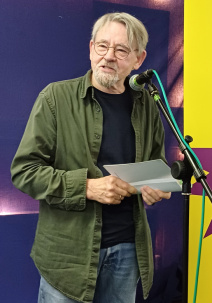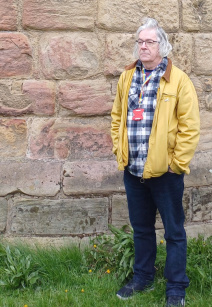It was sixty years ago this year ... university plans festival event to honour poetry landmark

An historic poetry landmark in Newcastle that hasn’t been open to the public for a long time but still captures literary imaginations reaches its 60th anniversary this year. Morden Tower, built around 1290 as part of the city’s medieval walls by Edward I, will be celebrated at a Newcastle poetry festival event next month. In the 1960s the tower, lacking electricity, sanitation, and indeed chairs, hosted a swathe of American poets including Allen Ginsberg, and was also responsible for the poetic resurrection of famed Modernist Basil Bunting, who had been languishing as a financial sub-editor at the Newcastle Chronicle, his eyesight and poetic ambition and reputation failing as he struggled to process the City prices.
On 16 June 1964 rookie poet Tom and his partner Connie Pickard, who had earlier that year taken a lease on Morden Tower for the princely sum of 10 shillings a week, staged their first poetry reading. The guest poet was Beat poet Pete Brown, who was part of the Liverpool scene in the 1960s and later lyricist for the band Cream. Their next guest was Basil Bunting, a poet with an extraordinary back-story, after Tom travelled out to nearby Wylam on the train to persuade him to give it a go.
Bunting said of the audience at his initial reading that they were “about fifty, half academics, half teenagers, with a sprinkling of thugs … a curious experience, reading to these youngsters. They were not hindered by the difficulties which annoy their elders. They took poetry as poetry - a nice noise – without questions about its ‘meaning’ … they were rapt at passages of intricate metric … I found it all very encouraging.” He was encouraged enough to publish what is seen as his masterpiece, Briggflatts, two years later, and gave his first reading of it in the tower on 22 December, 1965. Ginsberg also reported that at Morden Tower “I gave the most complete reading of my own written work that I ever vocalised in one evening”.

Tom Pickard has announced an “all-day bash” on 16 June this year at Tyneside Irish Centre in Newcastle to mark Morden Tower’s official 60th anniversary. He said on Facebook: “So far only the venue and a few bodies confirmed but no funding. Anybody feel they’d like to sponsor it let me know. I’ll be contacting folks involved in the tower over the years, poets, musicians, artists, talkers … we have the venue, afternoon and evening … tickets will be cheap and any profit to the NUFC fans foodbank.”
In 1990 High on the Walls, an anthology to mark 25 years of Morden Tower, was published by Bloodaxe, and featured an impressive list of poets that had read there, including Brown, Bunting, Ginsberg, Hugh MacDiarmid, Fleur Adcock, Ivor Cutler, Carol Ann Duffy, Helen Dunmore, Seamus Heaney, Liz Lochhead, Norman MacCaig, Ian McMillan, Barry MacSweeney, Adrian Mitchell, Henry Normal, Jeff Nuttall, Sean O’Brien, and JH Prynne. That’s only a few of them – there are many more, including Simon Armitage, Ted Hughes, Brian Patten, Robert Creeley, Lawrence Ferlinghetti and Gregory Corso.
In the anthology Ivor Cutler recalled: "My strongest memory is of the cold. And the shock of seeing a queue all the way from the pub to the front door of the Morden Tower waiting patiently in the sub-zero temperature to hear poetry."
Back in the 1960s the tower was sandwiched between some evil-smelling factories and a bus station. The bus station and the factories have long gone, and on one side of the tower, there is now a green sward. But it still backs on to piles of garbage and the rear side of restaurants along the alley on the other – and that area is still genuinely unsavoury. There was also clear evidence of a rough sleeper who had taken up residence in a niche in the ancient wall. These days the tower is locked and barred, as it has been for many years, and no one knows when, or if, it will ever host poetry events again.
I have long been, well, obsessed with Morden Tower as representing a crucial part of poetry history, long before I found myself permanently relocating to the north-east. Several years ago I tracked it down on a visit to Newcastle, and insisted my son take a picture of me in front of it. So I jumped at the chance of taking part in a poetry walk to the tower, even though we couldn’t get inside, and of being involved in a poetry festival event to commemorate it. After our first gathering we were sent away by poet and lecturer John Challis to each write a poem about the tower, and given a useful and impressive list of prompts, to be workshopped, and then delivered at a free event at the Newcastle poetry festival, which has as its theme In/Out of Place, on Saturday 11 May. This project is in conjunction with an exhibition about Morden Tower in the university’s Robinson library led by archivist Rachel Hawkes and researchers Maisie Drummond, Steve Kendall and Will Kerr.

I even know an audience member from that time. Liz Lennie, from Woking in Surrey, was a student and then a teacher in Newcastle back in the day. When I told her about the poetry festival event she was genuinely excited. She recalled “gazing up at a ranting Ginsberg” at Morden Tower, writing about the readings for Newcastle University’s student newspaper, visiting Tom and Connie’s home in Jesmond - and complaining to Basil Bunting at Morden Tower that “Hugh MacDiarmid had drunkenly kissed me on one ear, then being kissed by him [Bunting] on the other”.




